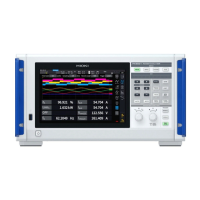31
2
Preparing for Measurement
DANGER
Do not connect any voltage cord or any current sensor to the primary
side of a distribution panel.
If a short circuit occurs on the primary side, an unrestricted current ow can damage
the instrument and facilities, resulting in serious bodily injury. Even if a short circuit
occurs on the secondary side of the distribution panel, the panel will interrupt the
short circuit current.
The procedure for preparation before measurement is as follows.
1
Inspect the instrument before use.
“2.1 Inspecting the Instrument before Use” (p. 32)
2
Connect the voltage cords and current sensors to the instrument.
“2.2 Connecting the Voltage Cords (Voltage Input)” (p. 33)
“2.3 Connecting the Current Sensors (Current Input)” (p. 34)
3
Supply power to the instrument.
“2.4 Supplying Power to the Instrument” (p. 39)
4
Set the measurement conditions.
“2.5 Setting Wiring Mode and Conguring Current Sensor Settings” (p. 41)
“2.6 Simple Conguration (Quick Set)” (p. 45)
5
Perform zero adjustment.
“2.7 Zero Adjustment and Degaussing (Demagnetization)” (p. 46)
6
Connect the cords and sensors to lines to be measured.
“2.8 Connecting Measurement Leads and Sensors to Lines to Be Measured” (p. 47)
7
Verify proper connection.
“2.9 Checking Connections” (p. 49)
Communication interface
• LAN
• GP-IB
• RS-232C
See “9 Connecting with computers”
(p. 157).
Saving data
See “7.1 USB Flash Drive” (p. 119).
External control
Integration control (Start/Stop/Reset)
See “8 Connecting External Devices”
(p. 143).
2 Preparing for Measurement
Preparing for Measurement

